Infiniti’s Q60 and QX30 a strong pair to draw to

Sometimes it gets annoying when you sit down to read your favorite monthly auto magazine, and find out that for the umpteenth consecutive issue, they’ve lumped six vehicles together for what seems like a quite convoluted and possibly biased comparison.
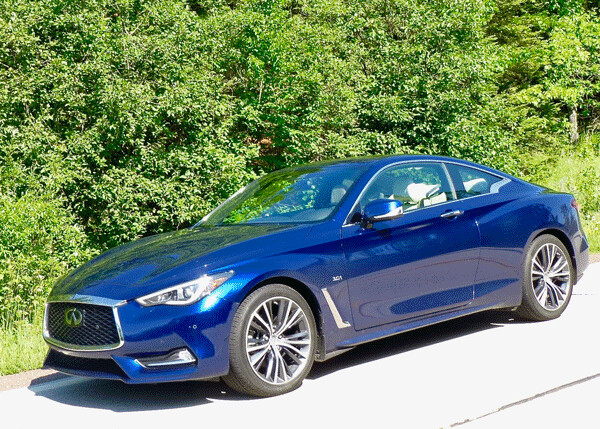
Here at New Car Picks, we don’t sink to such a trick...Except sometimes. This week, I would really rather devote a full column to the Infiniti QX30 Premium crossover SUV, and another full column to the Infiniti Q60, a super-sleek luxury sports coupe.
Separately, they are two of my favorite cars on the planet. But together, they could satisfy any family’s demands for having a sporty coupe and an SUV. And two versions of those gems arrived for me to drive for a week’s test drive in fairly close-order. Separating the two into separate road-tests is still my preference, but their close proximity in coming to me made it a natural to combine them into one elongated road test.
The two are joined at the hip — or maybe the transaxle — by sharing the extremely impressive 2.0-liter turbocharged 4-cylinder engine that has excellent power and even more impressive fuel economy. That 2.0 direct-injected 4 began life as a joint venture with Mercedes, which needed someone to produce just such a 4-cylinder for use in the C-Class sedans, and the smallest Mercedes SUVs, the GLA. Contracting with Nissan made a joint venture that gives a version of that engine to both companies.
Those who understand the heritage of the Q60 Coupe might recall that when Nissan spun off Infiniti into its own premium brand, the enlarged and much refined sports car that began life as the 240-Z and moved up to 260 and 280 on its way to 3.0, found a new home at Infiniti. The Infiniti Coupe always needed, or wanted, a high-powered upgrade, so the new Q60 offers a pair of 3.0-liter V6 engines, twin-turbocharged for kicks.
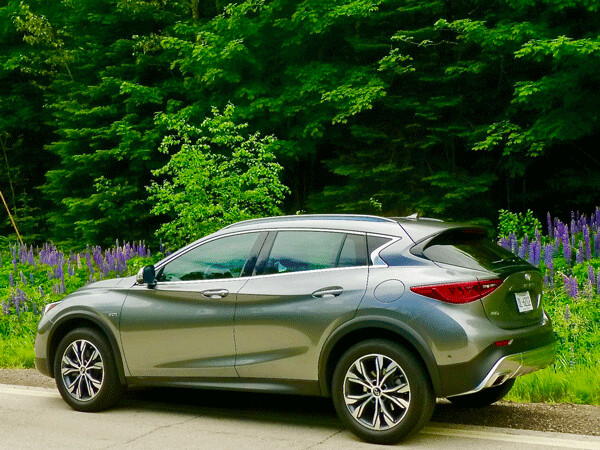
So while both vehicles have all-wheel drive, the dynamic QX30 Premium AWD is a remarkable over-achiever with the 2.0 direct-injected turbo, and the Q60 3.0t Premium AWD coupe moves up a weight class by using the 3.0 twin-turbo V6.
If I had to choose and pick just one, it would be a dilemma. The Q60 is a stunningly smooth coupe that attracts a lot of attention and would not be out of place in any car show; the QX30 is a uniquely designed vehicle, even for an SUV, because it is low and wears numerous contours that all seem to blend into a moving work of art.
So which would you choose? It might come down to whether you would really rather have a sports coupe or an SUV. On the other hand, the QX30 SUV is so quick and agile that it handles curves like a sports car, while the Q60 sports coupe blows your mind by offering all-wheel drive, and also has surprising and livable room in the back seat.

Infiniti makes a number of SUVs, all of them branded with QX-something. But the QX30 still caught me by surprise. Available with front-wheel drive only in base form, the Sport sits 0.6-inches lower, while the test vehicle was the AWD model that is 1.2 inches taller.
That 4-cylinder makes 208 horsepower with 258 foot-pounds of torque, and has a 7-speed dual clutch automatic with paddle shifters and three modes -- Economy, Sport and Manual. The AWD system sends 100 percent of its power to the front until it detects that you might have a slippery surface, and any hint of spinning alters the power to 50-50 front and rear.
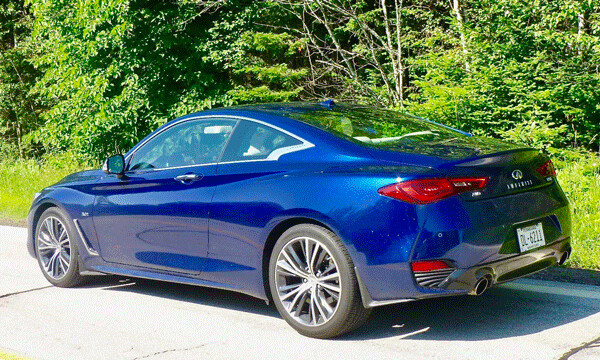
When you come to a complete stop at a stoplight, the engine shuts off, and restarts immediately when you take your foot off the brake to engage the gas pedal. My test-drive QX30 had the Cafe Teak package, with brown Nappa leather seats and dash, with genuine wood trim on the center stack and doors.
You sit low in the QX30, and your senses won’t tire of the asymmetric instrument panel. Nissan also reflects how advanced it is in safety stuff, with the 360-degree Around-View monitor with moving object detection. Infiniti was first to have that overhead-view device, probably a decade ago, and it’s still the best.
Blind-spot warning, intelligent cruise control with full-speed range and forward emergency braking, plus lane-departure warning, which also began with Infiniti years ago, and intelligent park assist, plus high-beam assist, which has become the favorite feature of my wife, Joan, especially with th eLED headlights on the test QX30.
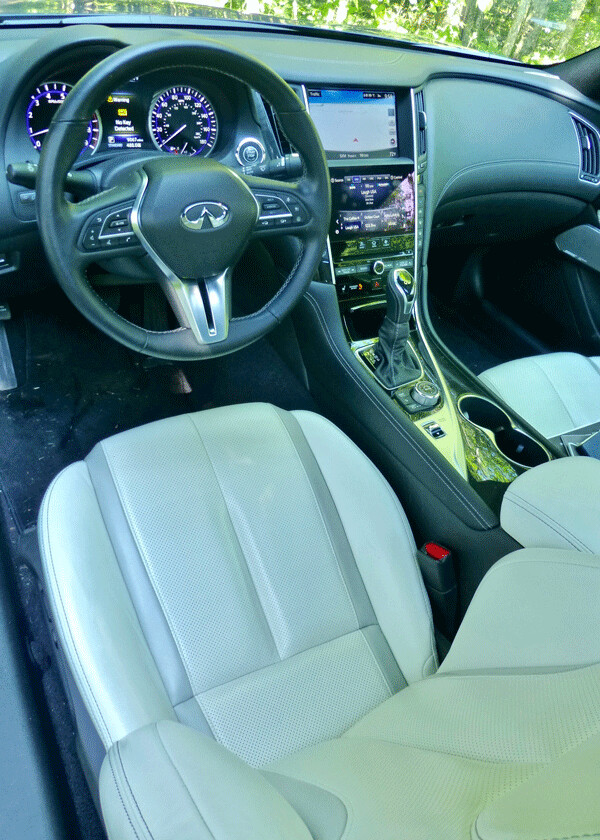
Sitting low and snaking around curves in the QX30 feeds your quest for a sports car, but it also can snap you back in focus when its foul weather, including Minnesota snowstorms, and you are reminded that this is an SUV, after all.
A panoramic sunroof, which Infiniti calls a moonroof, is also included, along with the usual vehicle dynamic control and brake force distribution on the antilock brakes, and an upgraded audio and navigation system. All of that runs the test-vehicle price up from its $37,700 sticker price to a final $46,035, but that’s with all the performance and safety equipment loaded up. The test car’s silver-grey Graphite-Shadow paint sets it off as a technology center, too.
I like SUVs, and I most like compact SUVs, but a compact SUV that has an identity crisis because it thinks it’s a sports car is something I hadn’t considered.
Then last week, the Q60 rolled up to my door. I know about the letter and number designations, but I was surprised to see a sporty, racy coupe. The 3.0t Premium coupe would have looked good in any color, but this happened to be Iridium Blue, which is a dark, penetrating, contrasted by white leather on the seats.
All-new for 2017, the Q60 3.0t Premium AWD Technology brings back the iconic Infiniti coupe in a technical tour de force. While you could start with the same 208-horsepower/258 foot-pounds of torque as the QX30, the move up to the twin-turbocharged 3.0-liter V6 offers 300 horsepower and 295 foot-pounds of torque. There is another, top version that hits 400 horsepower. Trust me, the 300/295 powerplant is more than adequate, but then I’d be happy with that over-achieving little 4 as well.
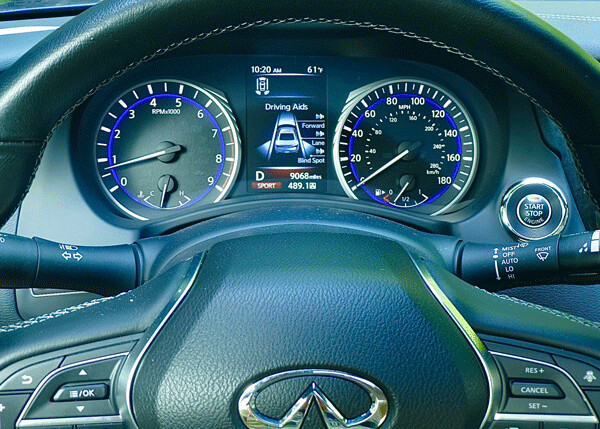
The sticker on the Q60 is $46,300 before you start adding the technology package, the direct adaptive steering, the leather seats, and the driver assistance package, which gather together the bline-spot assist, predictive forward collision warning, pedestria detecting forward braking, moving object detection anywhere in a 360-degree radius, back-up cross-traffic alert with collision intervention, and rain-sensing wipers. All that lifts the price tag to $57,255.
Naturally it has all the safety and proximity alert equipment as the QX30, and the sports coupe adds a killer Bose center-point surround audio system with 13 speakers.
More technology is available via a small toggle switch on the console, allowing you to switch from standard to eco to sport, sport-plus, or personal. Sport switches the car to heavier steering and quicker response, and firmer suspension. Sport-plus is more of the same, while eco backs you down to an easier ride and steering. The personal setting lets you mix and match to get the exact steering, ride and shift-point response.
Direct adaptive steering lets you control the tire angle and steering inputs to the wheels faster than a mechanical system could, and active trace control using light braking and engine output to the wheels to make the car handle even quicker and more precisely.
If the lane departure warning and blind spot warnings aren’t enough, you can set the Q60 for active lane control and blind spot intervention. Maybe you didn’t react quickly enough to the lane-departure warning, then the car can be instructed to push you back into your proper lane. These devices can be turned off, too.
During my week, I never did really hammer the Q60, because moderate throttle on takeoff or for passing pushed you prominently to where you wanted to be. Anything more, I figured, would have given me the means to test the extra police holiday patrolling.
The predictive forward collision warning measures your velocity as well as the car ahead, and the car ahead of that one, and warns if you are closing too fast.
If you’re just taking it easy, you might be in eco mode, which eases the sportiness of your steering and suspension, and -- get this -- signals you that you’re not driving in optimum economy mode by an indicator light, and by pushing back on your gas pedal pressure.
